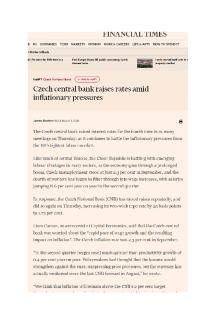Macroeconomics - UPDATED MACROECONOMIC ASSIGNMENT- KEYNESIAN VS. CLASSICAL ECONOMICS PDF

| Title | Macroeconomics - UPDATED MACROECONOMIC ASSIGNMENT- KEYNESIAN VS. CLASSICAL ECONOMICS |
|---|---|
| Course | Macroeconomics |
| Institution | University of the People |
| Pages | 4 |
| File Size | 121.6 KB |
| File Type | |
| Total Downloads | 89 |
| Total Views | 141 |
Summary
UPDATED MACROECONOMIC ASSIGNMENT- KEYNESIAN VS. CLASSICAL ECONOMICS...
Description
1 MACROECONOMICS
University of the People BUS 1104: Macroeconomics Professor Pravesh Nunkoo 21-04-2021
2 INTRODUCTION There are two models of macroeconomic economic theories that have been very popular in the recent centuries: Keynesian and Classical. Both have witnessed their days of glory and both have proponents on each side supporting the policies touted by each type of economics. This paper discusses the similarities and contrasts of both models as well as the recent development in Macroeconomics.
Similarities: Keynesian and Classical
According to Rittenberg and Tregarthen (2012), both models propose the importance and value of government spending to increase output and encourage economic activity. The Classical model holds that while personal spending and business investments should be the primary actions in an economy, it recognizes that in the absence of the aforementioned, government should intervene to create a conducive economic environment. Keynesian model also agrees that that excessive government spending creates employment, demand, and output.
The article “Keynesian Economics Vs. Classical Economics” (n.d) explains that both models support a creation of free market economy in which the forces of demand and supply decide the output and the value of that output. In short, while through different means, both Keynesian and Classical models are in favour of self-correction of the economy through demand and supply. Differences: Keynesian and Classical
Pettinger (2019) explains the key difference between both models in terms of importance placed on the supply side. Classical model argues that to strengthen the free market, the supply side is the most important and wages need to be up to a certain point for producers to produce more output. Keynesian model believes that supply side is not the most important factor to shift the demand curve to the right, especially in recession.
3 Classical model is a supporter of monetarism emphasizing the role of governments in controlling the amount of circulating money. Keynesian model encourages the fiscal policy to stabilize the economy by manipulating the levels and allocations of taxes and government expenditures. For instance, to stimulate growth, taxes are lowered and spending is increased, often involving borrowing. How does each handle issues of unemployment?
According to the Keynesian model, consumer demand is the primary driving force in an economy and economies are boosted through a healthy amount of output coupled with sufficient economic expenditures. The proponents of this model believed that unemployment was caused by a lack of expenditures which decreased aggregate demand. The base concept of Keynesian model is to create affective demand to create affective output for an effective income level. The classical model believed that any unemployment must be considered voluntary, as workers must accept a set wage level in the economy. “In addition, the need workers have to buy goods will encourage them to accept work, even at lower wage rates” (Saylor Academy, n.d). New developments in the 1980s The advancements that marked the inception of the new macroeconomic school of thought began in 1979 with a war between Iran and Iraq. The rising oil prices depressed the aggregate supply as it increased the costs for the suppliers to produce other goods. This led to increase in price levels of goods owing to the increase in the cost of production resulting from high oil prices. At the same time, the decrease in tax rates and increased government spending along with increase in money supply and lower interest rates pushed up the aggregate demand. This prompted the government to practice contractionary monetary policy. President Reagan’s time witnessed a budget deficit as a result of the expansionary policy which then prompted President George Bush to raise taxes to curb the deficit. This led to the development of the New Keynesian Economics which builds on Maynard’s Keynesian model that expansionary fiscal policy is still indeed the best form of economic growth as compared to the very unreliable expansionary monetary policies.
4 References: “Keynesian Economics Vs. Classical Economics: Similarities And Differences” (n.d). The freeman online. https://www.thefreemanonline.org/keynesian-economics-vs-classical-economics/ Rittenberg, L. and Tregarthen, T. (2012) Macroeconomics Principles. https://2012books.lardbucket.org/pdfs/macroeconomics-principles-v2.0.pdf Pettinger, T. (2019). Keynesian vs Classical models and policies. https://www.economicshelp.org/keynesian-vsclassical-models-and-policies/#:~:text=Classical%20economics%20places%20little%20emphasis,policy%2C %20especially%20in%20a%20recession. Saylor Academic (n.d). ECON102: Principles of Macroeconomics. https://learn.saylor.org/mod/page/view.php? id=7642
Garcia, M. (2017). Salon bookkeeping methods. Retrieved from https://bizfluent.com/how-12196373-tobookkeeping-rental-booth-stylists.html McCool, C. (2020). Cash basis accounting vs. accrual accounting. Retrieved from https://bench.co/blog/accounting/cash-vs-accrual-accounting/#:~:text=The%20difference%20between%20cash %20and%20accrual%20accounting%20lies%20in%20the,billed%20(but%20not%20paid)....
Similar Free PDFs

Economics IA - Macroeconomics
- 4 Pages

Classical vs Operant 2
- 3 Pages

Macroeconomic
- 657 Pages

48840-Assignment 1 - Updated
- 2 Pages
Popular Institutions
- Tinajero National High School - Annex
- Politeknik Caltex Riau
- Yokohama City University
- SGT University
- University of Al-Qadisiyah
- Divine Word College of Vigan
- Techniek College Rotterdam
- Universidade de Santiago
- Universiti Teknologi MARA Cawangan Johor Kampus Pasir Gudang
- Poltekkes Kemenkes Yogyakarta
- Baguio City National High School
- Colegio san marcos
- preparatoria uno
- Centro de Bachillerato Tecnológico Industrial y de Servicios No. 107
- Dalian Maritime University
- Quang Trung Secondary School
- Colegio Tecnológico en Informática
- Corporación Regional de Educación Superior
- Grupo CEDVA
- Dar Al Uloom University
- Centro de Estudios Preuniversitarios de la Universidad Nacional de Ingeniería
- 上智大学
- Aakash International School, Nuna Majara
- San Felipe Neri Catholic School
- Kang Chiao International School - New Taipei City
- Misamis Occidental National High School
- Institución Educativa Escuela Normal Juan Ladrilleros
- Kolehiyo ng Pantukan
- Batanes State College
- Instituto Continental
- Sekolah Menengah Kejuruan Kesehatan Kaltara (Tarakan)
- Colegio de La Inmaculada Concepcion - Cebu











